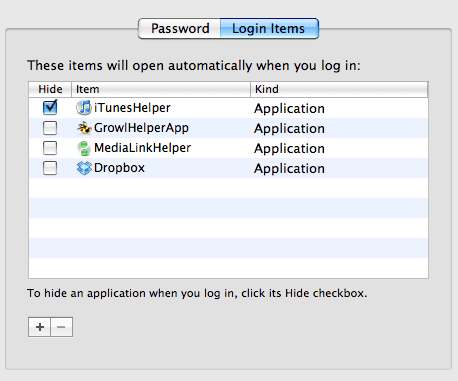A handful of users have reported significantly slower system startup after the update to Mac OS X 10.6.4. There are a variety of causes and corresponding fixes for this issue (which crops up for some users after virtually every Mac OS X update), but there are three commonly successful, easy procedures that can eliminate the issue in most cases.
Before beginning these procedures, note that the first boot after a Mac OS X update often takes longer than normal. If subsequent restarts occur at a normal speed, you don’t have a problem.
First thing to try: boot in safe mode
Booting your Mac in Safe Mode then simply restarting normally is one of the most overlooked, most effective procedures for solving a variety of issues after an incremental Mac OS X update, including performance problems. The reason for its efficacy: booting in Safe Mode forces a disk directory check, clears potentially problematic cache files and performs other routines, detailed here.
To boot in Safe Mode, hold the Shift key while your Mac is starting up. After booting in Safe Mode, simply restart normally (without holding the Shift key) and check for persistence of the issue.
Second thing to try: reinstall the combo updater
Download the Mac OS X 10.6.4 combo updater, which weighs in at a hefty 887MB. Quit all open applications and run the installer.
Third thing to try: remove startup and login items
Login and/or startup items can exhibit compatibility issues with new Mac OS X releases, and therefore slowdown startup times. Your best be is to remove all of these types of items that come from third parties, then add them back individually or in groups to identify the problematic ones.
Login Items. Open System Preferences from Apple menu (upper-left corner of the screen) then click “Accounts.” Choose your current account from the left pane, then click the “Login Items” tab in the right pane. Deselect all items except those installed by Apple, such as “iTunes Helper” (you may need to click the lock box in the lower left of the screen to make changes). Save the changes, then restart and check for performance issues.
Startup Items. Look in root level of your startup drive (e.g. Macintosh HD). Navigate to Library/StartupItems. Remove all items to a safe location. Restart and check to see if you still have slow startup.
You can also use Activity Monitor to check for processes that might be causing the slowdown.
- Launch Activity Monitor (access Spotlight in the upper-right corner of the screen, and beging to type “Activity Monitor”)
- In the top menubar, switch from “My Processes” to “All Processess” using the drop-down menu
- Look for any third-party processes that might be running the background and slowing down startup .
